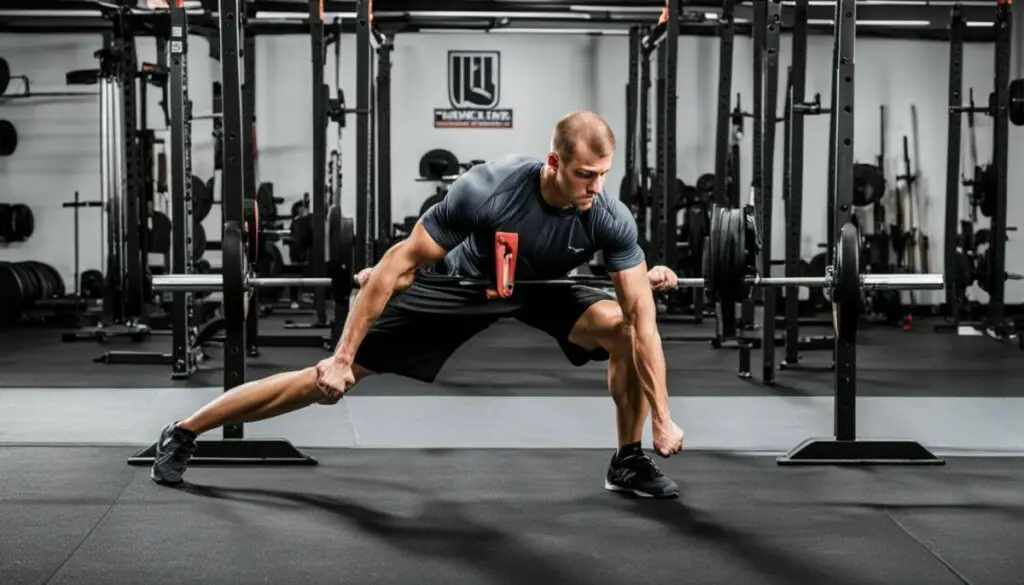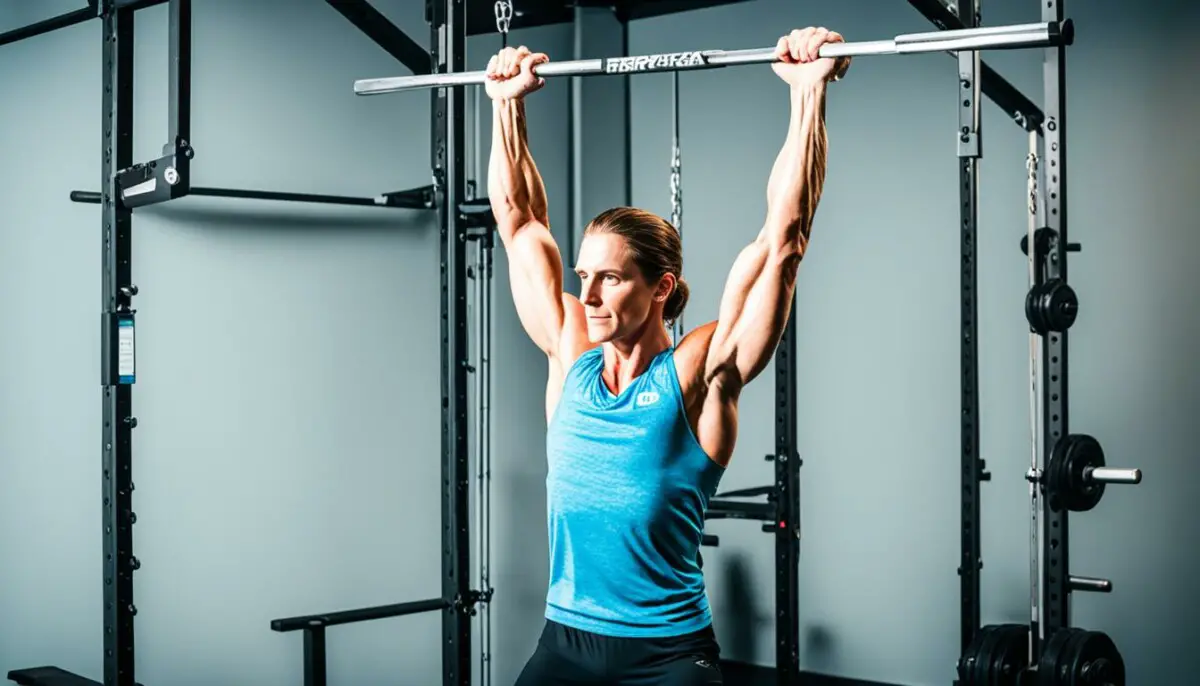Last Updated on 3 months by Francis
The trap bar row is a highly effective exercise for building strength and optimizing your workout. It offers numerous benefits compared to traditional barbell rows, including better grip options and a more natural movement pattern. The trap bar allows for a neutral grip, reducing the risk of biceps tears and offering a more comfortable pull. Mastering the proper form is essential for maximizing the benefits of trap bar rows.
Contents
Key Takeaways:
- Trap bar rows provide better grip options and a more natural movement pattern compared to traditional barbell rows.
- The exercise targets the back muscles, particularly the lats, traps, and rhomboids, while also engaging the biceps and rear deltoids.
- Proper technique is crucial for maximizing results and preventing injuries during trap bar rows.
- Avoid common mistakes such as rounding the back and using excessive momentum.
- Trap bar rows are suitable for individuals with anatomical limitations and can be incorporated into various workout routines.
The Benefits of Trap Bar Rows

Trap bar rows offer a wide range of benefits, making them a valuable addition to any workout routine. Let’s explore the advantages of incorporating trap bar rows into your strength training program.
Muscles Worked with Trap Bar Rows
Trap bar rows target several key muscle groups, helping you build strength and develop a well-rounded physique. The primary muscles worked during trap bar rows include:
- Lats (Latissimus Dorsi): The lats are the largest muscles in your back and play a crucial role in pulling movements. Trap bar rows engage the lats, helping you develop a strong and defined back.
- Traps (Trapezius): The traps are responsible for shoulder and neck movement, and trap bar rows effectively target these muscles. Developing strong traps not only improves aesthetics but also helps with posture and upper body stability.
- Rhomboids: Located between the shoulder blades, the rhomboids play a vital role in retracting and stabilizing the scapulae. Trap bar rows activate the rhomboids, helping to improve posture and upper body strength.
- Biceps: While primarily a back exercise, trap bar rows also engage the biceps as secondary muscles. This provides an additional stimulus for the arms, promoting overall arm development.
- Rear Deltoids: The rear deltoids, located at the back of the shoulders, are also involved during trap bar rows. Targeting the rear delts helps create balanced shoulder development and enhances overall upper body strength.
By targeting these major muscle groups, trap bar rows provide a comprehensive workout for the upper body, helping you build strength, muscle size, and functional fitness.
Variations of Trap Bar Rows
Variety is essential in any workout routine to prevent boredom and continuously challenge your muscles. Trap bar rows offer various variations that can be incorporated to add variety and target different muscle groups. Some common trap bar row variations include:
- Single-Arm Rows: Performing trap bar rows with one arm at a time helps to isolate and develop each side of your back individually. This can aid in addressing muscle imbalances and improving overall symmetry.
- T-Bar Rows: T-bar rows use a T-bar attachment or a landmine setup combined with the trap bar to create a different movement pattern. This variation places more emphasis on the mid-back muscles, providing a unique stimulus for your back workout.
By incorporating these trap bar row variations into your routine, you can target specific muscle groups, challenge your body in new ways, and continuously make progress towards your fitness goals.
| Benefits of Trap Bar Rows | Muscles Worked | Variations |
|---|---|---|
| Improved strength and muscle development | Lats, traps, rhomboids, biceps, rear deltoids | Single-arm rows, T-bar rows |
Proper Technique for Trap Bar Rows

Performing trap bar rows with the correct technique is crucial for maximizing results and preventing injuries. Follow these steps to ensure proper form and effectiveness:
- Position yourself inside the trap bar with your shins aligned with or just in front of the center of the bar.
- Push your butt back and bend your knees to lower yourself into a squat position.
- Grip the handles tightly, keeping your hands shoulder-width apart.
- Maintain a neutral head position with your gaze fixed forward.
- Squeeze your shoulder blades together and engage your core muscles.
- Initiate the lift by pushing through your feet and standing up while maintaining a strong posture.
- As you lift, keep your back straight and avoid rounding your shoulders.
- Lower the weight back down by bending your knees and pushing your butt back.
- Repeat the movement for the desired number of repetitions, maintaining proper form throughout.
Note: It’s important to ensure proper form and technique throughout the entire range of motion to effectively target the intended muscle groups.
Common Mistakes to Avoid
While performing trap bar rows, it’s essential to avoid common mistakes that can compromise your form and prevent optimal muscle engagement. Some common mistakes include:
- Rounding the back, which can strain the spine and reduce the effectiveness of the exercise.
- Using excessive momentum instead of focusing on controlled movements.
- Not fully extending the arms during the rowing motion, which limits muscle activation.
By maintaining a neutral spine, using controlled movements, and fully contracting the targeted muscles, you can ensure that you get the most out of your trap bar row workout.
Common Mistakes to Avoid

While performing trap bar rows, it’s important to be aware of the common mistakes that can hinder your progress and prevent you from achieving optimal results. By avoiding these mistakes and focusing on proper form, you can ensure that you are effectively targeting the intended muscle groups and maximizing the benefits of trap bar rows.
Rounding the Back
One common mistake is rounding the back during the rowing motion. This not only reduces the effectiveness of the exercise but also puts unnecessary strain on the spine. It’s crucial to maintain a neutral spine throughout the movement, keeping your back flat and engaged to fully target the muscles of your upper back and core.
Using Excessive Momentum
Another mistake to avoid is using excessive momentum to complete the row. This often happens when individuals use momentum from their lower body to lift the weight instead of relying on the strength of their back muscles. By performing each repetition with controlled and deliberate movements, you can ensure that you are effectively engaging the target muscles and avoiding unnecessary strain on other parts of your body.
Not Fully Extending the Arms
It is important to fully extend your arms during the rowing motion. Failing to do so can limit the range of motion and prevent you from fully contracting and engaging the back muscles. By extending your arms fully at the end of each repetition, you ensure that you are maximizing the activation of these muscles and promoting better overall muscle development.
Remember, it’s not about how much weight you can lift or how many repetitions you can perform; it’s about maintaining proper form and engaging the right muscles to get the most out of your trap bar row workout.
Avoiding these common mistakes and focusing on maintaining a neutral spine, using controlled movements, and fully extending your arms will help you achieve proper form and maximize the benefits of trap bar rows.
| Mistake | Impact | Correction |
|---|---|---|
| Rounding the back | Reduces effectiveness of the exercise and strains the spine | Maintain a neutral spine and engage your core |
| Using excessive momentum | Compromises muscle engagement and can lead to injury | Focus on controlled movements and rely on back muscles |
| Not fully extending the arms | Limits range of motion and hinders muscle contraction | Ensure arms are fully extended at the end of each repetition |
Who Should Do Trap Bar Rows

Trap bar rows are a versatile exercise that can benefit a wide range of individuals, particularly those with anatomical limitations or back issues that find traditional barbell rows uncomfortable or challenging. Unlike barbell rows, trap bar rows offer a more natural movement pattern and provide better grip options, allowing for a more comfortable and effective workout.
Additionally, trap bar rows are especially beneficial for those focused on building muscle rather than sport-specific performance. The exercise targets key muscle groups, including the lats, traps, and rhomboids, as well as the biceps and rear deltoids. By incorporating trap bar rows into your workout routine, you can effectively engage and develop your back muscles, promoting strength and overall fitness.
Whether you’re just starting out or have been training for years, trap bar rows can be easily modified to suit your fitness level. They can be incorporated into various workout routines, serving as a great supplement to traditional barbell rows or as a standalone exercise for back development. With their versatility and numerous benefits, trap bar rows are an excellent addition to any strength training program.
Don’t let physical limitations or discomfort hold you back from maximizing your workout potential. Give trap bar rows a try and experience the benefits for yourself.
Benefits of Trap Bar Rows:
- More natural movement pattern compared to barbell rows
- Allows for a more comfortable and effective grip
- Targets key muscle groups, including the lats, traps, and rhomboids
- Engages the biceps and rear deltoids
- Versatile exercise that can be modified to suit different fitness levels
- Can be incorporated into various workout routines
- Great supplement to traditional barbell rows or as a standalone exercise for back development
Take a look at the image below to see the proper form for trap bar rows:
“Trap bar rows are a game-changer! They’ve helped me overcome back issues and build strength in my upper body. I love how they target my back muscles without straining my biceps. Highly recommended!” – Emily, fitness enthusiast
Adding Trap Bar Rows to Your Workouts
Incorporating trap bar rows into your workout routine can provide a fresh stimulus for your back muscles and help you break through plateaus. By adding this compound exercise to your routine, you’ll be able to target multiple muscle groups, including your lats, traps, and rhomboids, while also engaging your biceps and rear deltoids.
Here are some tips to effectively add trap bar rows to your workouts:
- Pair with Other Exercises: Consider performing trap bar rows as part of a full-body or upper body strength workout. Pair them with exercises that target other muscle groups, such as squats, bench presses, or overhead presses. This will allow you to maximize your training efficiency and work multiple muscle groups in one session.
- Experiment with Variations: To add variety and challenge to your workouts, you can experiment with different variations of trap bar rows. One popular variation is the single-arm row, which allows you to focus on one side of your back at a time and also engages your core for stability.
Sample Workout Plan:
Here’s an example of how you can incorporate trap bar rows into your upper body strength training routine:
| Exercise | Sets | Reps | Rest |
|---|---|---|---|
| Bench Press | 3 | 8-10 | 60 seconds |
| Trap Bar Rows | 3 | 10-12 | 60 seconds |
| Overhead Press | 3 | 8-10 | 60 seconds |
| Tricep Dips | 3 | 10-12 | 60 seconds |
Remember to start with a weight that allows you to maintain proper form throughout the exercise. As you become stronger and more comfortable, gradually increase the weight to keep progressing and challenging your muscles.
Adding trap bar rows to your workouts can be an effective way to strengthen your back muscles and enhance your overall strength training routine. By incorporating different variations and pairing them with other exercises, you can keep your workouts engaging and continually challenge your muscles to grow and adapt.
A Comparison: Trap Bar Rows vs Barbell Rows
While both trap bar rows and barbell rows have their advantages, trap bar rows offer unique benefits due to the neutral grip handle and the more natural movement pattern. Trap bar rows specifically target the back muscles more effectively and reduce the risk of biceps tears compared to barbell rows. Additionally, trap bar rows provide an opportunity to lift heavier weights and challenge the muscles in a different way.
When comparing trap bar rows and barbell rows, it’s important to consider your goals and preferences. If you’re looking to maximize back muscle engagement, reduce the risk of biceps tears, and challenge yourself with heavier weights, trap bar rows are an excellent choice. On the other hand, if you prefer using a barbell and are comfortable with the traditional rowing movement pattern, barbell rows may be more suitable for you.
To help you make an informed decision, here’s a comparison of the benefits offered by trap bar rows and barbell rows:
| Trap Bar Rows | Barbell Rows |
|---|---|
| Target the back muscles more effectively | Target the back muscles |
| Reduce the risk of biceps tears | Higher risk of biceps tears |
| Allow for heavier weights to be lifted | Limited by grip strength |
| Provide a more natural movement pattern | Follow a traditional rowing movement pattern |
As you can see, trap bar rows offer several advantages over barbell rows, making them a valuable addition to your strength training routine.
Tips for Progressing with Trap Bar Rows
To continually challenge yourself and make progress with trap bar rows, consider implementing progressive overload principles. Start by selecting a weight that allows you to perform the exercise with proper form and gradually increase the weight as you become stronger and more comfortable. Additionally, varying the rep range, rest periods, and incorporating other rowing variations can further enhance your progress.
Progressive Overload
Progressive overload is a fundamental principle in strength training that involves gradually increasing the stress placed on your muscles over time. By consistently challenging your muscles with heavier weights or more repetitions, you stimulate growth and strength gains.
When starting with trap bar rows, focus on mastering the proper technique and developing a strong foundation. Start with a weight that allows you to perform the exercise with good form and without straining. Aim for a weight that allows you to complete around 8-12 repetitions with proper technique.
As you become more comfortable with the exercise, progressively increase the weight. Add small increments, such as 5-10 pounds, to each side of the trap bar. Gradually increasing the weight will help you build strength and continue to make progress.
Vary Rep Range and Rest Periods
To further challenge your muscles and prevent plateaus, vary the rep range and rest periods. Incorporating different rep ranges, such as performing sets of 6-8 repetitions or 12-15 repetitions, stimulates different muscle fibers and promotes overall muscle development. Additionally, adjusting the rest periods between sets can alter the intensity of your workout and challenge your muscles in different ways.
For example, if you typically rest for 60 seconds between sets, try shortening the rest period to 30 seconds to increase the metabolic stress on your muscles. Alternatively, you can lengthen the rest periods to 2-3 minutes to focus on maximum strength and allow for full recovery between sets.
Experiment with Rowing Variations
To keep your trap bar row workouts interesting and target different muscle groups, consider incorporating various rowing variations. Here are a few options to try:
- Single-Arm Rows: Instead of using both hands on the trap bar, perform the exercise with one arm at a time. This variation challenges your core stability and allows for a greater range of motion.
- Speed Rows: Increase the tempo of your rowing motion, focusing on explosive concentric contractions. This variation improves power and muscular endurance.
- T-Bar Rows: Attach a V-handle or landmine attachment to the trap bar and perform rows with a neutral grip. This variation targets the back muscles from a different angle.
By incorporating these variations into your trap bar row workouts, you can add variety, challenge your muscles in new ways, and prevent boredom.
Remember, progressing with trap bar rows is a gradual process. Listen to your body, prioritize proper form, and always work within your limits. With consistent effort and smart programming, you’ll continue to make strides in strength and overall fitness.
Conclusion
Incorporating trap bar rows into your workout routine can be a game-changer for building strength and optimizing your workout. This exercise offers a safer and more effective alternative to traditional barbell rows, thanks to its unique design and numerous benefits. By mastering the proper technique and progressively challenging yourself, you can maximize the benefits of trap bar rows and take your strength training to the next level.
The trap bar row is highly beneficial for targeting and developing key back muscles like the lats, traps, and rhomboids. It also engages the biceps and rear deltoids, making it a comprehensive exercise for your upper body. With trap bar rows, you have the added advantage of better grip options and a more natural movement pattern. The neutral grip reduces the risk of biceps tears and provides a comfortable pulling motion that alleviates stress on the wrists and shoulders.
To perform trap bar rows with the proper technique, position yourself inside the trap bar, align your shins with or just in front of the center of the bar, and grip the handles tightly. Maintain a neutral head position and fixed gaze, while activating your core and squeezing your shoulder blades. Initiate the lift by pushing through your feet and standing up, then lower the weight back down by bending your knees and pushing your butt back. Avoid common mistakes like rounding your back or using excessive momentum to ensure maximum muscle engagement and prevent injury.
FAQ
What are the benefits of trap bar rows?
Trap bar rows offer numerous benefits, including better grip options, a more natural movement pattern, and reduced risk of biceps tears compared to traditional barbell rows. They target the back muscles, particularly the lats, traps, and rhomboids, while also engaging the biceps and rear deltoids. Trap bar rows can also be performed with various techniques and variations to add variety to your workout routine and target different muscle groups.
How do I perform trap bar rows with proper technique?
To perform trap bar rows with proper technique, start by positioning yourself inside the trap bar with your shins aligned with or just in front of the center of the bar. Push your butt back, bend your knees, and grip the handles tightly. Keep your head in a neutral position and your gaze fixed forward. Squeeze your shoulder blades, activate your core, and initiate the lift by pushing through your feet and standing up. Lower the weight back down by bending your knees and pushing your butt back. Maintain proper form throughout the exercise to effectively target the intended muscle groups.
What are some common mistakes to avoid when doing trap bar rows?
Common mistakes to avoid when doing trap bar rows include rounding the back, using excessive momentum, and not fully extending the arms during the rowing motion. It’s important to maintain a neutral spine, use controlled movements, and fully contract the targeted muscles to get the most out of your trap bar row workout.
Who should do trap bar rows?
Trap bar rows are suitable for a wide range of individuals, including those with anatomical limitations or back issues that make traditional barbell rows uncomfortable or challenging. They can also be beneficial for those primarily focused on building muscle rather than sport-specific performance. Trap bar rows can be incorporated into various workout routines, serving as a great supplement to traditional barbell rows or as a standalone exercise for back development.
How can I incorporate trap bar rows into my workouts?
You can incorporate trap bar rows into your workout routine by performing them as part of a full-body or upper body strength workout, pairing them with exercises that target other muscle groups. You can also experiment with different variations of trap bar rows, such as single-arm rows, to add variety and challenge to your workouts.
How do trap bar rows compare to barbell rows?
Trap bar rows offer unique benefits compared to barbell rows due to the neutral grip handle and more natural movement pattern. Trap bar rows target the back muscles more effectively and reduce the risk of biceps tears. They also provide an opportunity to lift heavier weights and challenge the muscles in a different way. The choice between trap bar rows and barbell rows depends on your goals and preferences.
How can I progress with trap bar rows?
To continually challenge yourself and make progress with trap bar rows, consider implementing progressive overload principles. Start by selecting a weight that allows you to perform the exercise with proper form and gradually increase the weight as you become stronger and more comfortable. Varying the rep range, rest periods, and incorporating other rowing variations can further enhance your progress.








